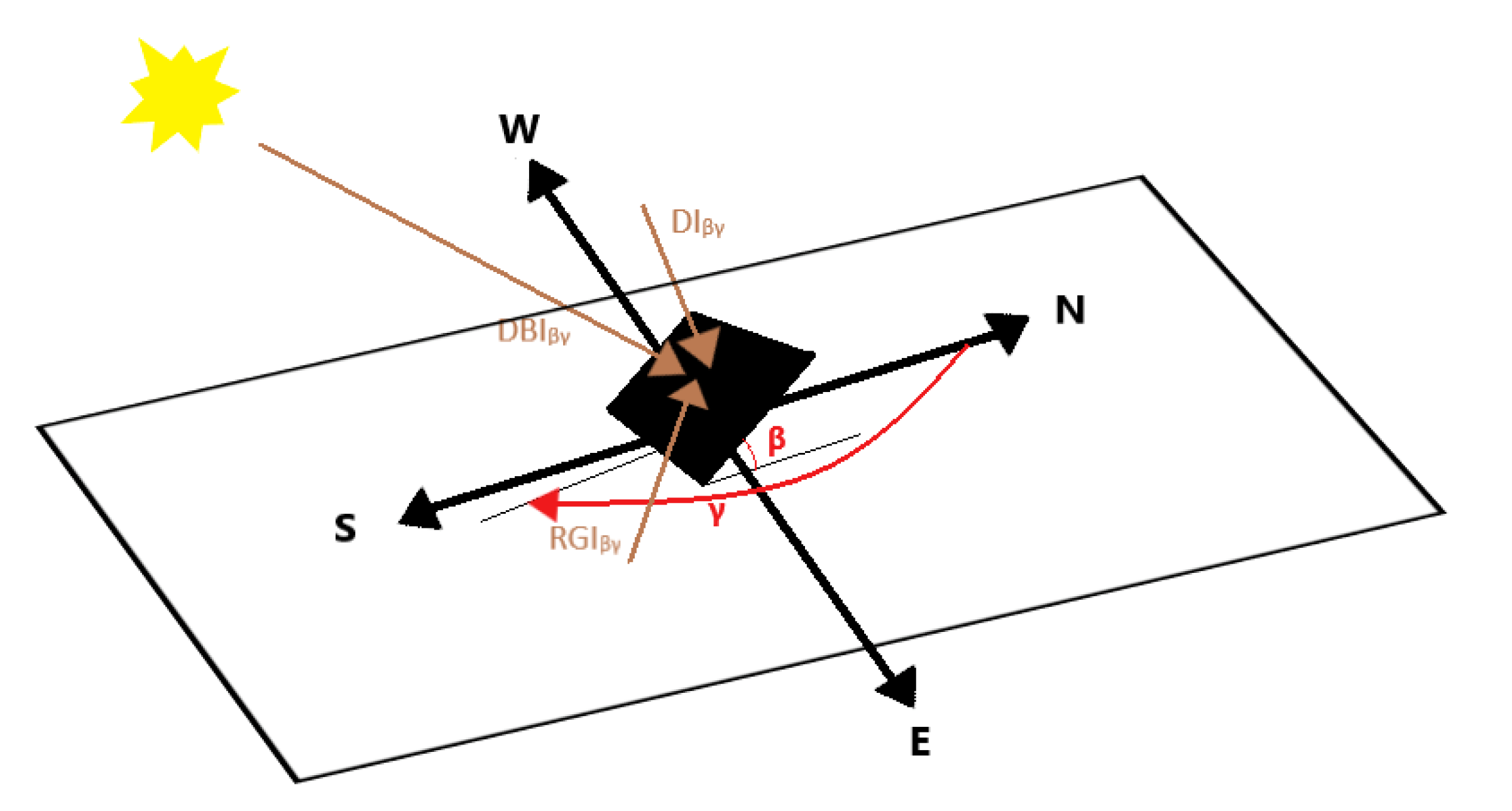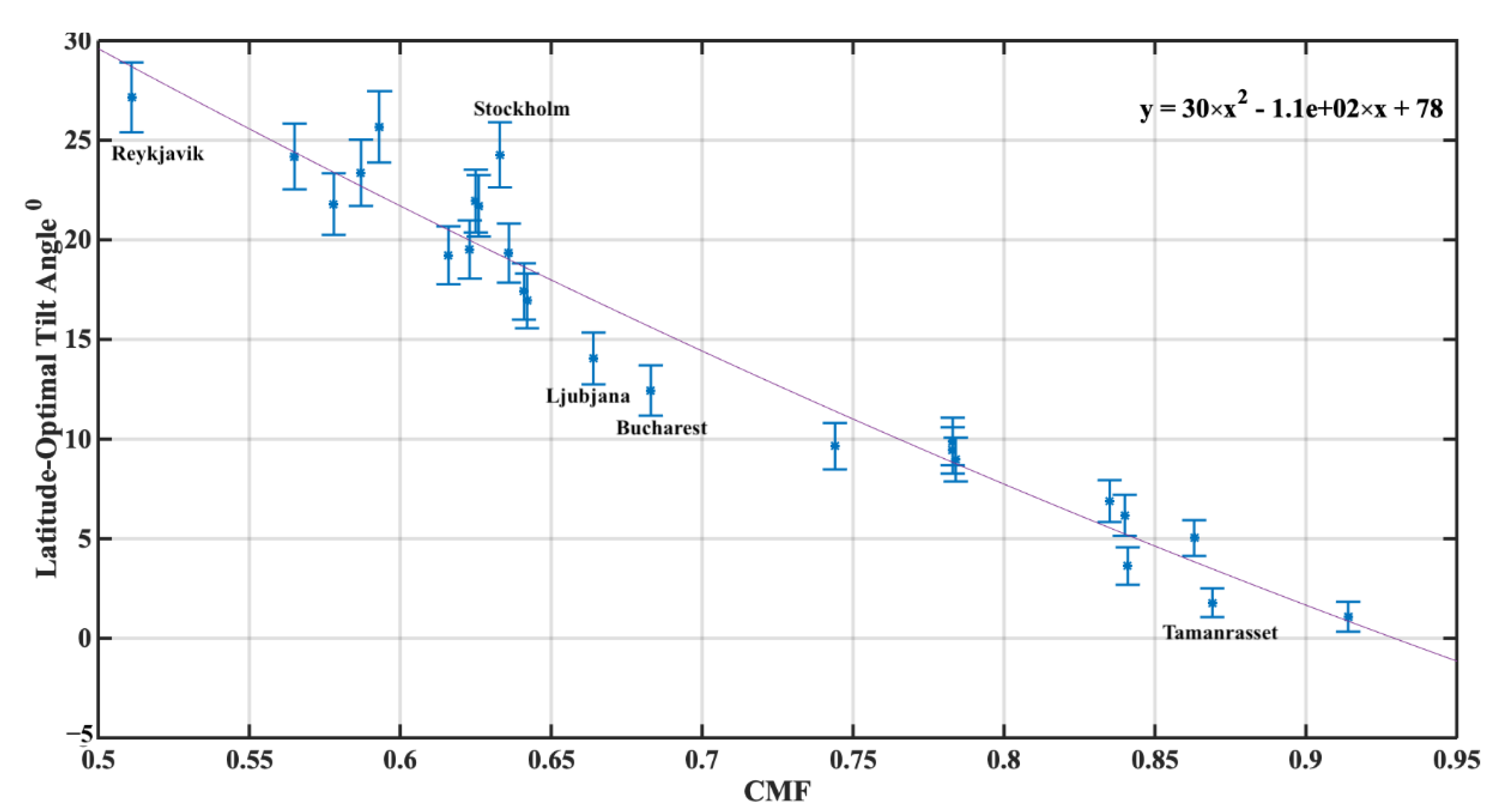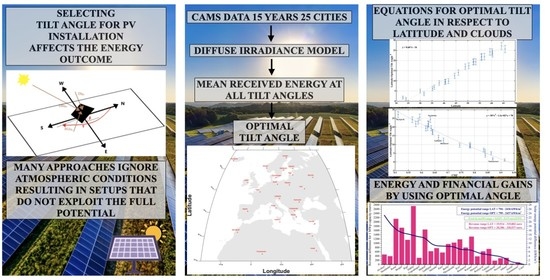Selecting Surface Inclination for Maximum Solar Power
Abstract
:1. Introduction
2. Data and Methods
2.1. Data Sets
- (i)
- GHI ≥ 0.19 W/m2;
- (ii)
- GHI ≤ 1.12 × Isc;
- (iii)
- DHI ≤ 1.1 × GHI;
- (iv)
- DHI ≤ 0.8 × Isc, and
- (v)
- BHI ≤ Isc
2.2. Diffuse Irradiance Models
3. Results
3.1. Model Comparison
3.2. Optimum Angle per City
3.3. Cloud Effect
3.4. Energy/Financial Profits
4. Discussion
5. Conclusions
Author Contributions
Funding
Data Availability Statement
Acknowledgments
Conflicts of Interest
Appendix A
References
- Malm, A. Fossil Capital: The Rise of Steam-Power and the Roots of Global Warming; Verso: London, UK; New York, NY, USA, 2016; ISBN 978-1-78478-129-3. [Google Scholar]
- Kåberger, T. Progress of Renewable Electricity Replacing Fossil Fuels. Glob. Energy Interconnect. 2018, 1, 48–52. [Google Scholar] [CrossRef]
- Shukla, P.R.; Skea, J.; Slade, R.; Al Khourdajie, A.; van Diemen, R.; McCollum, D.; Pathak, P.; Some, S.; Vyas, P.; Fradera, R.; et al. IPCC, 2022: Climate Change 2022: Mitigation of Climate Change. In Contribution of Working Group III to the Sixth Assessment Report of the Intergovernmental Panel on Climate Change; IPCC: Geneva, Switzerland, 2022. [Google Scholar]
- Renewables Global Futures Report: Great Debates towards 100% Renewable Energy; REN21: Paris, France, 2017.
- IEA (2021), Renewables 2021. Available online: https://www.iea.org/reports/renewables-2021 (accessed on 1 May 2022).
- Mehleri, E.D.; Zervas, P.L.; Sarimveis, H.; Palyvos, J.A.; Markatos, N.C. Determination of the Optimal Tilt Angle and Orientation for Solar Photovoltaic Arrays. Renew. Energy 2010, 35, 2468–2475. [Google Scholar] [CrossRef]
- Kaldellis, J.; Zafirakis, D. Experimental Investigation of the Optimum Photovoltaic Panels’ Tilt Angle during the Summer Period. Energy 2012, 38, 305–314. [Google Scholar] [CrossRef]
- Raptis, P.I.; Kazadzis, S.; Psiloglou, B.; Kouremeti, N.; Kosmopoulos, P.; Kazantzidis, A. Measurements and Model Simulations of Solar Radiation at Tilted Planes, towards the Maximization of Energy Capture. Energy 2017, 130, 570–580. [Google Scholar] [CrossRef]
- Kocer, A.; Yaka, I.F.; Sardogan, G.T.; Gungor, A. Effects of Tilt Angle on Flat-Plate Solar Thermal Collector Systems. Curr. J. Appl. Sci. Technol. 2015, 9, 77–85. [Google Scholar] [CrossRef]
- Tong, X.; Sun, Z.; Sigrimis, N.; Li, T. Energy Sustainability Performance of a Sliding Cover Solar Greenhouse: Solar Energy Capture Aspects. Biosyst. Eng. 2018, 176, 88–102. [Google Scholar] [CrossRef]
- Kacira, M.; Simsek, M.; Babur, Y.; Demirkol, S. Determining Optimum Tilt Angles and Orientations of Photovoltaic Panels in Sanliurfa, Turkey. Renew. Energy 2004, 29, 1265–1275. [Google Scholar] [CrossRef]
- Lave, M.; Kleissl, J. Optimum Fixed Orientations and Benefits of Tracking for Capturing Solar Radiation in the Continental United States. Renew. Energy 2011, 36, 1145–1152. [Google Scholar] [CrossRef] [Green Version]
- Rowlands, I.H.; Kemery, B.P.; Beausoleil-Morrison, I. Optimal Solar-PV Tilt Angle and Azimuth: An Ontario (Canada) Case-Study. Energy Policy 2011, 39, 1397–1409. [Google Scholar] [CrossRef]
- Díez-Mediavilla, M.; Rodríguez-Amigo, M.; Dieste-Velasco, M.; García-Calderón, T.; Alonso-Tristán, C. The PV Potential of Vertical Façades: A Classic Approach Using Experimental Data from Burgos, Spain. Sol. Energy 2019, 177, 192–199. [Google Scholar] [CrossRef]
- Wang, M.; Mao, X.; Gao, Y.; He, F. Potential of Carbon Emission Reduction and Financial Feasibility of Urban Rooftop Photovoltaic Power Generation in Beijing. J. Clean. Prod. 2018, 203, 1119–1131. [Google Scholar] [CrossRef]
- Mohammad, S.T.; Al-Kayiem, H.H.; Aurybi, M.A.; Khlief, A.K. Measurement of Global and Direct Normal Solar Energy Radiation in Seri Iskandar and Comparison with Other Cities of Malaysia. Case Stud. Therm. Eng. 2020, 18, 100591. [Google Scholar] [CrossRef]
- Nassar, Y.F.; Hafez, A.A.; Alsadi, S.Y. Multi-Factorial Comparison for 24 Distinct Transposition Models for Inclined Surface Solar Irradiance Computation in the State of Palestine: A Case Study. Front. Energy Res. 2020, 7, 163. [Google Scholar] [CrossRef]
- Serrano-Guerrero, X.; Cantos, E.; Feijoo, J.-J.; Barragán-Escandón, A.; Clairand, J.-M. Optimal Tilt and Orientation Angles in Fixed Flat Surfaces to Maximize the Capture of Solar Insolation: A Case Study in Ecuador. Appl. Sci. 2021, 11, 4546. [Google Scholar] [CrossRef]
- Darhmaoui, H.; Lahjouji, D. Latitude based model for tilt angle optimization for solar collectors in the Mediterranean region. Energy Procedia 2013, 42, 426–435. [Google Scholar] [CrossRef] [Green Version]
- Chang, Y.-P. Optimal Design of Discrete-Value Tilt Angle of PV Using Sequential Neural-Network Approximation and Orthogonal Array. Expert Syst. Appl. 2009, 36, 6010–6018. [Google Scholar] [CrossRef]
- Nicolás-Martín, C.; Santos-Martín, D.; Chinchilla-Sánchez, M.; Lemon, S. A Global Annual Optimum Tilt Angle Model for Photovoltaic Generation to Use in the Absence of Local Meteorological Data. Renew. Energy 2020, 161, 722–735. [Google Scholar] [CrossRef]
- Salata, F.; Ciancio, V.; Dell’Olmo, J.; Golasi, I.; Palusci, O.; Coppi, M. Effects of Local Conditions on the Multi-Variable and Multi-Objective Energy Optimization of Residential Buildings Using Genetic Algorithms. Appl. Energy 2020, 260, 114289. [Google Scholar] [CrossRef]
- Petrović, E.; Jović, M.; Nikolić, V.; Mitrović, D.; Laković, M. Particle Swarm Optimization for the Optimal Tilt Angle of Solar Collectors. In Proceedings of the Sixteenth Symposium on Thermal Science and Engineering of Serbia, Sokobanja, Serbia, 22–25 October 2013. [Google Scholar]
- Jacobson, M.Z.; Jadhav, V. World Estimates of PV Optimal Tilt Angles and Ratios of Sunlight Incident upon Tilted and Tracked PV Panels Relative to Horizontal Panels. Sol. Energy 2018, 169, 55–66. [Google Scholar] [CrossRef]
- NREL (National Renewable Energy Laboratory), 2017. PV Watts Calculator. Available online: http://Pvwatts.Nrel.Gov (accessed on 4 November 2017).
- Chinchilla, M.; Santos-Martín, D.; Carpintero-Rentería, M.; Lemon, S. Worldwide Annual Optimum Tilt Angle Model for Solar Collectors and Photovoltaic Systems in the Absence of Site Meteorological Data. Appl. Energy 2021, 281, 116056. [Google Scholar] [CrossRef]
- Oumbe, A.; Qu, Z.; Blanc, P.; Lefèvre, M.; Wald, L.; Cros, S. Decoupling the Effects of Clear Atmosphere and Clouds to Simplify Calculations of the Broadband Solar Irradiance at Ground Level. Geosci. Model Dev. 2014, 7, 1661–1669. [Google Scholar] [CrossRef] [Green Version]
- de Miguel, A.; Bilbao, J.; Aguiar, R.; Kambezidis, H.; Negro, E. Diffuse Solar Irradiation Model Evaluation in the North Mediterranean Belt Area. Sol. Energy 2001, 70, 143–153. [Google Scholar] [CrossRef]
- Kopp, G.; Lean, J.L. A new, lower value of total solar irradiance: Evidence and climate significance. Geophys. Res. Lett. 2011, 38. [Google Scholar] [CrossRef] [Green Version]
- Parisi, A.V.; Turnbull, D.J.; Turner, J. Calculation of cloud modification factors for the horizontal plane eye damaging ultraviolet radiation. Atmos. Res. 2007, 86, 278–285. [Google Scholar] [CrossRef]
- Lefèvre, M.; Oumbe, A.; Blanc, P.; Espinar, B.; Gschwind, B.; Qu, Z.; Wald, L.; Schroedter-Homscheidt, M.; Hoyer-Klick, C.; Arola, A.; et al. McClear: A New Model Estimating Downwelling Solar Radiation at Ground Level in Clear-Sky Conditions. Atmos. Meas. Tech. 2013, 6, 2403–2418. [Google Scholar] [CrossRef] [Green Version]
- Liu, B.; Jordan, R. Daily Insolation on Surfaces Tilted towards Equator. ASHRAE J. 1961, 10. [Google Scholar]
- Hay, J.E. Calculation of Monthly Mean Solar Radiation for Horizontal and Inclined Surfaces. Sol. Energy 1979, 23, 301–307. [Google Scholar] [CrossRef]
- Reindl, D.T.; Beckman, W.A.; Duffie, J.A. Evaluation of Hourly Tilted Surface Radiation Models. Sol. Energy 1990, 45, 9–17. [Google Scholar] [CrossRef]
- Perez, R.; Ineichen, P.; Seals, R.; Michalsky, J.; Stewart, R. Modeling Daylight Availability and Irradiance Components from Direct and Global Irradiance. Sol. Energy 1990, 44, 271–289. [Google Scholar] [CrossRef] [Green Version]
- David, M.; Lauret, P.; Boland, J. Evaluating Tilted Plane Models for Solar Radiation Using Comprehensive Testing Procedures, at a Southern Hemisphere Location. Renew. Energy 2013, 51, 124–131. [Google Scholar] [CrossRef] [Green Version]
- Tian, Z.; Perers, B.; Furbo, S.; Fan, J.; Deng, J.; Dragsted, J. A Comprehensive Approach for Modelling Horizontal Diffuse Radiation, Direct Normal Irradiance and Total Tilted Solar Radiation Based on Global Radiation under Danish Climate Conditions. Energies 2018, 11, 1315. [Google Scholar] [CrossRef] [Green Version]
- Gueymard, C. Critical Analysis and Performance Assessment of Clear Sky Solar Irradiance Models Using Theoretical and Measured Data. Sol. Energy 1993, 51, 121–138. [Google Scholar] [CrossRef]
- Gkikas, A.; Proestakis, E.; Amiridis, V.; Kazadzis, S.; Di Tomaso, E.; Marinou, E.; Hatzianastassiou, N.; Kok, J.F.; García-Pando, C.P. Quantification of the Dust Optical Depth across Spatiotemporal Scales with the MIDAS Global Dataset (2003–2017). Atmos. Chem. Phys. 2022, 22, 3553–3578. [Google Scholar] [CrossRef]
- Papachristopoulou, K.; Fountoulakis, I.; Gkikas, A.; Kosmopoulos, P.G.; Nastos, P.T.; Hatzaki, M.; Kazadzis, S. 15-Year Analysis of Direct Effects of Total and Dust Aerosols in Solar Radiation/Energy over the Mediterranean Basin. Remote Sens. 2022, 14, 1535. [Google Scholar] [CrossRef]
- Kosmopoulos, P.; Kazadzis, S.; El-Askary, H.; Taylor, M.; Gkikas, A.; Proestakis, E.; Kontoes, C.; El-Khayat, M. Earth-Observation-Based Estimation and Forecasting of Particulate Matter Impact on Solar Energy in Egypt. Remote Sens. 2018, 10, 1870. [Google Scholar] [CrossRef] [Green Version]
- Fountoulakis, I.; Kosmopoulos, P.; Papachristopoulou, K.; Raptis, I.-P.; Mamouri, R.-E.; Nisantzi, A.; Gkikas, A.; Witthuhn, J.; Bley, S.; Moustaka, A.; et al. Effects of Aerosols and Clouds on the Levels of Surface Solar Radiation and Solar Energy in Cyprus. Remote Sens. 2021, 13, 2319. [Google Scholar] [CrossRef]
- Dumka, U.C.; Kosmopoulos, P.G.; Ningombam, S.S.; Masoom, A. Impact of Aerosol and Cloud on the Solar Energy Potential over the Central Gangetic Himalayan Region. Remote Sens. 2021, 13, 3248. [Google Scholar] [CrossRef]
- Dumka, U.C.; Kosmopoulos, P.G.; Patel, P.N.; Sheoran, R. Can Forest Fires Be an Important Factor in the Reduction in Solar Power Production in India? Remote Sens. 2022, 14, 549. [Google Scholar] [CrossRef]
- International Renewable Energy Agency. Future of Solar PV. 2019. Available online: https://irena.org/-/media/Files/IRENA/Agency/Publication/2019/Nov/IRENA_Future_of_Solar_PV_2019.pdf (accessed on 18 June 2022).
- National Renewable Energy Laboratory. Best Research-Cell Efficiency Chart. 2022. Available online: https://www.nrel.gov/pv/cell-efficiency.html (accessed on 18 June 2022).
- Arias-Rosales, A.; LeDuc, P.R. Shadow modeling in urban environments for solar harvesting devices with freely defined positions and orientations. Renew. Sustain. Energy Rev. 2022, 164, 112522. [Google Scholar] [CrossRef]
- Rao, A.; Pillai, R.; Mani, M.; Ramamurthy, P. Influence of dust deposition on photovoltaic panel performance. Energy Procedia 2014, 54, 690–700. [Google Scholar] [CrossRef] [Green Version]
- PVGIS. Photovoltaic Geographical Information System. Available online: http://re.jrc.ec.europa.eu/pvgis/ (accessed on 18 June 2022).
- Bird, R.E.; Riordan, C. Simple Solar Spectral Model for Direct and Diffuse Irradiance on Horizontal and Tilted Planes at the Earth’s Surface for Cloudless Atmospheres. J. Appl. Meteorol. Climatol. 1986, 25, 87–97. [Google Scholar] [CrossRef] [Green Version]
- Wild, M. Global Dimming and Brightening: A Review. J. Geophys. Res. Atmos. 2009, 114, D00D16. [Google Scholar] [CrossRef] [Green Version]
- Leibensperger, E.M.; Mickley, L.J.; Jacob, D.J.; Chen, W.-T.; Seinfeld, J.H.; Nenes, A.; Adams, P.J.; Streets, D.G.; Kumar, N.; Rind, D. Climatic Effects of 1950–2050 Changes in US Anthropogenic Aerosols—Part 1: Aerosol Trends and Radiative Forcing. Atmos. Chem. Phys. 2012, 12, 3333–3348. [Google Scholar] [CrossRef] [Green Version]
- Inness, A.; Ades, M.; Agustí-Panareda, A.; Barré, J.; Benedictow, A.; Blechschmidt, A.-M.; Dominguez, J.J.; Engelen, R.; Eskes, H.; Flemming, J.; et al. The CAMS Reanalysis of Atmospheric Composition. Atmos. Chem. Phys. 2019, 19, 3515–3556. [Google Scholar] [CrossRef] [Green Version]
- Gueymard, C.A.; Yang, D. Worldwide Validation of CAMS and MERRA-2 Reanalysis Aerosol Optical Depth Products Using 15 Years of AERONET Observations. Atmos. Environ. 2020, 225, 117216. [Google Scholar] [CrossRef]
- Mortier, A.; Gliß, J.; Schulz, M.; Aas, W.; Andrews, E.; Bian, H.; Chin, M.; Ginoux, P.; Hand, J.; Holben, B.; et al. Evaluation of Climate Model Aerosol Trends with Ground-Based Observations over the Last 2 Decades—An AeroCom and CMIP6 Analysis. Atmos. Chem. Phys. 2020, 20, 13355–13378. [Google Scholar] [CrossRef]









| Optimum Angle | Hay | ISO | Reindl | Perez | Mean | σ |
|---|---|---|---|---|---|---|
| Nicosia | 28.8 | 28.47 | 29.67 | 31.27 | 29.55 | 1.25 |
| Athens | 28.33 | 28.27 | 29.13 | 30.87 | 29.15 | 1.21 |
| Bergen | 37.07 | 38.13 | 38.8 | 40.40 | 38.60 | 1.40 |
| Reykjavik | 33.53 | 35.27 | 35.67 | 37.87 | 35.59 | 1.78 |
| kWh/m2/Day | Hay | ISO | Reindl | Perez | Mean | σ |
|---|---|---|---|---|---|---|
| Nicosia | 5.81 | 5.71 | 5.83 | 5.93 | 5.82 | 0.09 |
| Athens | 5.15 | 5.08 | 5.17 | 5.26 | 5.17 | 0.07 |
| Bergen | 2.75 | 2.69 | 2.76 | 2.85 | 2.76 | 0.07 |
| Reykjavik | 2.20 | 2.16 | 2.21 | 2.28 | 2.21 | 0.05 |
| City | Country | Lat | Long | βopt | <CMF> | <AOD> |
|---|---|---|---|---|---|---|
| Tamanrasset | Algeria | 22.78 | 5.51 | 21 | 0.869 | 0.312 |
| Aswan | Egypt | 24.09 | 32.89 | 23 | 0.914 | 0.310 |
| Cairo | Egypt | 30.03 | 31.24 | 25 | 0.863 | 0.282 |
| Marrakesh | Morocco | 31.63 | −7.98 | 28 | 0.841 | 0.205 |
| Nicosia | Cyprus | 35.17 | 33.36 | 29 | 0.840 | 0.245 |
| Valletta | Malta | 35.89 | 14.51 | 29 | 0.835 | 0.238 |
| Athens | Greece | 37.98 | 23.72 | 29 | 0.784 | 0.222 |
| Madrid | Spain | 40.43 | −3.70 | 31 | 0.783 | 0.140 |
| Thessaloniki | Greece | 40.65 | 22.92 | 31 | 0.744 | 0.232 |
| Rome | Italy | 41.88 | 12.47 | 32 | 0.783 | 0.197 |
| Bucharest | Romana | 44.44 | 26.08 | 32 | 0.683 | 0.224 |
| Ljubljana | Slovenia | 46.05 | 14.50 | 32 | 0.664 | 0.196 |
| Paris | France | 48.94 | 2.41 | 32 | 0.642 | 0.178 |
| Kyiv | Ukraine | 50.41 | 3050 | 33 | 0.641 | 0.190 |
| Warsaw | Poland | 52.23 | 21.00 | 33 | 0.616 | 0.192 |
| Berlin | Germany | 52.52 | 13.37 | 33 | 0.623 | 0.180 |
| Dublin | Ireland | 53.34 | −6.28 | 34 | 0.636 | 0.170 |
| Copenhagen | Denmark | 55.71 | 12.54 | 34 | 0.626 | 0.161 |
| Moscow | Moscow | 55.8 | 37.59 | 34 | 0.578 | 0.176 |
| Riga | Lithuania | 56.95 | 24.11 | 35 | 0.625 | 0.158 |
| Stockholm | Sweden | 59.27 | 18.02 | 35 | 0.633 | 0.137 |
| Helsinki | Finland | 60.19 | 24.93 | 36 | 0.565 | 0.137 |
| Bergen | Norway | 60.37 | 5.32 | 37 | 0.587 | 0.145 |
| Reykjavik | Iceland | 64.16 | −21.95 | 37 | 0.511 | 0.138 |
| Alvsbyn | Norway | 65.68 | 20.99 | 40 | 0.593 | 0.101 |
Publisher’s Note: MDPI stays neutral with regard to jurisdictional claims in published maps and institutional affiliations. |
© 2022 by the authors. Licensee MDPI, Basel, Switzerland. This article is an open access article distributed under the terms and conditions of the Creative Commons Attribution (CC BY) license (https://creativecommons.org/licenses/by/4.0/).
Share and Cite
Raptis, I.-P.; Moustaka, A.; Kosmopoulos, P.; Kazadzis, S. Selecting Surface Inclination for Maximum Solar Power. Energies 2022, 15, 4784. https://doi.org/10.3390/en15134784
Raptis I-P, Moustaka A, Kosmopoulos P, Kazadzis S. Selecting Surface Inclination for Maximum Solar Power. Energies. 2022; 15(13):4784. https://doi.org/10.3390/en15134784
Chicago/Turabian StyleRaptis, Ioannis-Panagiotis, Anna Moustaka, Panagiotis Kosmopoulos, and Stelios Kazadzis. 2022. "Selecting Surface Inclination for Maximum Solar Power" Energies 15, no. 13: 4784. https://doi.org/10.3390/en15134784
APA StyleRaptis, I.-P., Moustaka, A., Kosmopoulos, P., & Kazadzis, S. (2022). Selecting Surface Inclination for Maximum Solar Power. Energies, 15(13), 4784. https://doi.org/10.3390/en15134784










